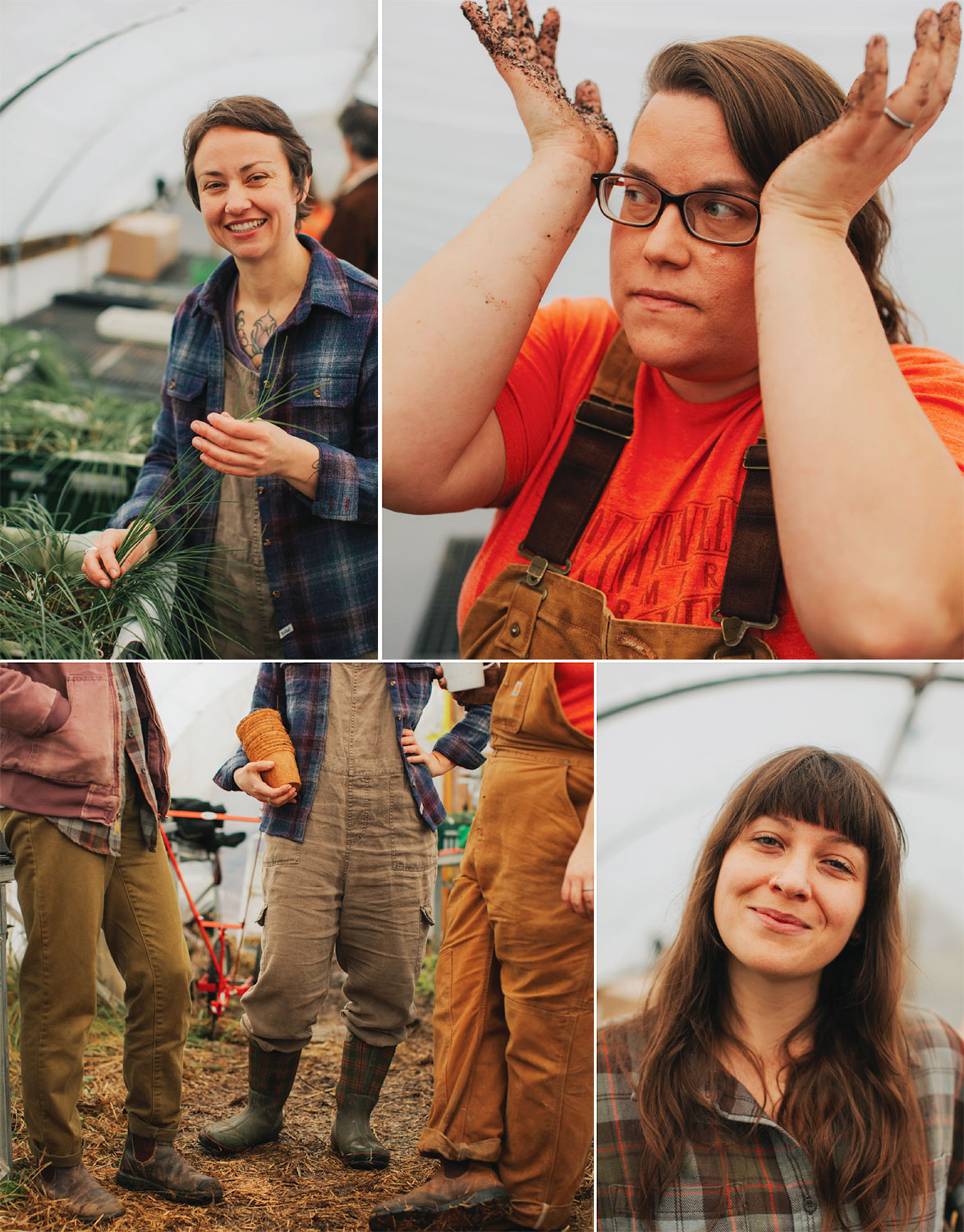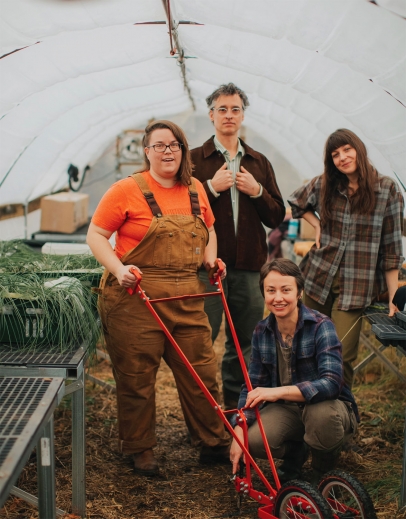Growing Pains
Shedding light on the struggles of young farmers
Instead of battening down the hatches on a snowy night, I am slip-sliding my way through downtown Columbus to a curiously named event.
“Board Games for Bored Farmers” is a gathering hosted by the Central Ohio Chapter of the National Young Farmers Coalition (NYFC), a nonprofit organization that advocates for the future of agriculture and supports young farmers, bringing them together for conversation and connection. I’m similar in age to many of those gathered here, but I’m no farmer. I grew up in the center of Columbus, where school field trips were mostly art museums and theatres, or visits to even bigger cities like Chicago. My outdoor time consisted mostly of riding my bike on uneven sidewalks, and apart from the occasional handful of grapes that I would snatch from my grandmother’s garden, my exposure to any farm life was virtually nonexistent.
As I sit down with them, I quickly realize these young farmers are anything but bored.
They are brimming with passion for farming, which is incredibly reassuring given the current farming crisis our nation is facing.
According to the United States Department of Agriculture (USDA), between 2007 and 2012 agriculture gained 2,384 farmers between ages 25 and 34—but lost nearly 100,000 between 45 and 54.
To replace these losses, farming has to be an attractable career choice for younger generations. Yet I soon learn that getting started in farming doesn’t come without struggles, especially for young farmers.
Among the largest of these struggles: access to muchneeded capital. Having the money to buy seeds and equipment, build the necessary infrastructure and obtain land to do all of this is no easy hurdle to overcome.
Purchasing farmland outright is essentially out of reach for many young farmers. In fact, obtaining access to affordable land is the top challenge cited by young farmers, according to the NYFC, and is the main reason some farmers quit farming and why other aspiring farmers haven’t started.
Many of the young farmers I am speaking with are first-generation farmers. I can’t even fathom the steepness of this learning curve—like learning the best growing and ranching approaches, what people like to eat and how to implement sustainable farming practices.
Farming isn’t a profession that is untouched by gender and racial inequalities either. It is paramount to note that the challenges farmers face are not experienced equally. Oftentimes female farmers express concerns about not being taken seriously or incidents of sexual harassment, which typically leaves a female farmer no choice but to look for work on another farm or to start her own.
For people of color, immigrants, indigenous and biracial populations, access to funding, land and infrastructure is more difficult. According to the USDA, only 7% of farmers in the U.S. are people of color.
With so many seemingly insurmountable hurdles, why do young farmers brave the leap into agriculture?
“I’m so happy being outside—in any weather—doing manual labor,” says Lauren Hirtle, vice president of the Central Ohio Chapter of the NYFC.
For Kate Hodges, member, urban farmer and co-owner of Foraged & Sown, “It’s caring about a place and taking care of that place.”
I learn it also goes beyond being stewards of the land. It’s about sharing—choosing community over competition. Kate continues, “I like to make things, and it’s important to me to share beyond just myself or my immediate circle. Sharing for other people.”
“According to the United States Department of Agriculture (USDA), between 2007 and 2012 agriculture gained 2,384 farmers between ages 25 and 34—but lost nearly 100,000 between 45 and 54.”

These passionate farmers are why the NYFC was created—to foster a place that would allow them to grow in their business skills, farming expertise and local community. The organization currently has chapters in 28 states, which allows members to address issues on both a federal and state level.
Lauren founded the Central Ohio Chapter initially for friendship but was also drawn to the idea of a community of farmers who could connect, learn from one another and share their struggles. And perhaps share in the occasional board game.
“It’s really great to hear across the country how other people are able to enact change to help with the things that they are struggling with,” says Kate.
One of the biggest benefits of joining the chapter is also the smallest: seeds, or I should say, the discount on them, which helps to relieve some of the financial burdens for the early season.
“The discount on seeds alone is worth the membership,” says Lauren.
“Yes, everybody should join just to get discounts on seeds,” laughs Kate.
On the national level, the NYFC serves as a united front to advocate for policy change to benefit young farmers.
When it comes to land access, the organization is striving to make land more accessible to young farmers through improving access to credit and funding as well as incentives for land transition between old and young farmers. To relieve some of the financial burden from student loans, NYFC is also advocating for an amendment to the Public Service Loan Forgiveness Plan to include farmers.
The NYFC is also pushing Congress to prioritize climate-smart conservation programs. In a 2017 survey, 55% of farmers attributed unpredictability in weather patterns to climate change.
To address racial inequality, the coalition is demanding that Congress significantly increases support for programs that help underserved farmers and ranchers gain access to land and government services.
While this support is necessary, these enthusiastic young farmers share with me that some of the easiest ways to support them can start right here within the community.
For example, consider participating in a local CSA membership, where customers purchase a subscription to receive seasonal produce each week throughout the farming season. This model helps farmers obtain the capital critical to the early growing season and in return community members get ultra-fresh food. Farmers are keen to meet their customers and that can mean more than just at the farmers markets.
“Anyone can attend the [chapter] meetings; it’s not just for members. Anyone at all who is interested in farming or local food or agriculture politics,” Lauren says.
Cultivating curiosity about where our foods come from and the faces behind the hard work can lead to deeper relationships within our community. It can close the gap between eaters and the ones who continue to endure inclement weather, setbacks and stress to bring us both joy and sustenance.
Shuffling my way across Columbus in the snow to meet these young farmers now seems to pale in comparison to the struggles these farmers weather every day in order to share their bounty with us.
I’ve learned so much from these farmers, and my promise to them is to keep learning.
“Food has value,” says Kate, “beyond the thing that you’re buying.”
After meeting with these special people who make up Central Ohio’s NYFC Chapter, I now realize all the care, strength and resilience it takes to place even a single radish into the palm of my hand.
To learn more about the NYFC and their efforts, visit youngfarmers. org. To get involved in the Central Ohio Chapter, visit their Facebook Page @centralohioyoungfarmerscoalition for more information and upcoming events.





